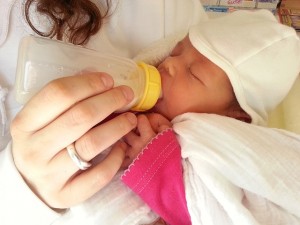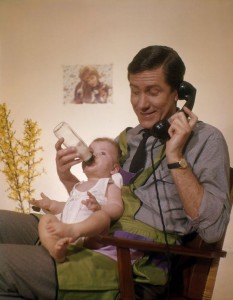Not every mother wants to breast-feed her baby. Some cannot do so for a variety of reasons, e.g. wanting to return to work, or having to take medication, or some simply prefer bottle feeding.
Bottle feeding is quite satisfactory if the right precautions are taken, and most babies will thrive on it. There is a wide variety of specially prepared formulas for babies, but almost all are based on cow’s milk. Milk, whether human or from a cow, is 90 per cent water, and it is in the remaining 10 per cent that the differences in food substances lie. Cow’s milk may be modified to bring it closer to human milk.
If you are bottle feeding, then your baby will be started on this method with a commercial formula.

In the United States, such a formula is available to everybody regardless of the family’s financial means. Most families can buy the formula at a local store. But, if their means are limited, they can obtain such a formula through the WIC program.
Commercial formula comes premixed in a bottle ready to feed or as a powder to be added to sterile water, or as concentrated formula to be diluted with water. The nipple-bottle premixed formula unit is the most convenient and the most expensive.
The powdered formula requires more preparation but is less expensive.
Breast milk comes ready mixed”. There is no way of succumbing to any temptation of adding one for the pot,” or putting in that spoonful of sugar” because he likes it sweet. The pharmaceutical manufacturers have carefully prepared artificial feeding formula to simulate human milk.
It is important to mix formula according to the manufacturer’s instructions, always to use the scoop provided, and never to add sugar unless specifically told to do so by your doctor.
Breast milk is sterile, and breast-fed babies have added protection through their mothers’ antibodies which a bottle-fed baby cannot receive. It is therefore important to develop a routine for the sterilization of bottles and nipples. Remember that scrupulously clean hands are most important.
It is wise to use paper towels, if possible, for drying them, as a less than clean hand towel will undo all your good work. One advantage of bottle feeding is that the mother need not always be available to give it in person.
This is of course true, but it is not necessarily a good thing. If nature’s way is to make sure that this particular mother-baby couple (the nursing couple) is together at regular intervals, day in, day out for the first few weeks then truly successful bottle feeding may also depend on just this regularity and closeness.
Obviously, there are bound to be exceptions, and one of these will be.
The night when the mother is desperately tired and the father gives the night feeding. For most of the time, however, it is probably better if the nursing couple remains the same, and the time the mother spends cuddling and talking to her baby is most important.

However, some fathers like to join in this relationship by assuming one of the feedings each day. It is the inevitability of close physical contact during breast-feeding which constitutes one of the major differences between breast-and bottle feeding.
But, if the mother is careful to provide cuddling and eye-to-eye contact with her baby, there should be no less mother-infant bonding with bottle-feeding. It is all a matter of attitude.
This is a time for physical contact and love. Bottle feeding, however, is the father’s only chance to take part in the feeding process.
